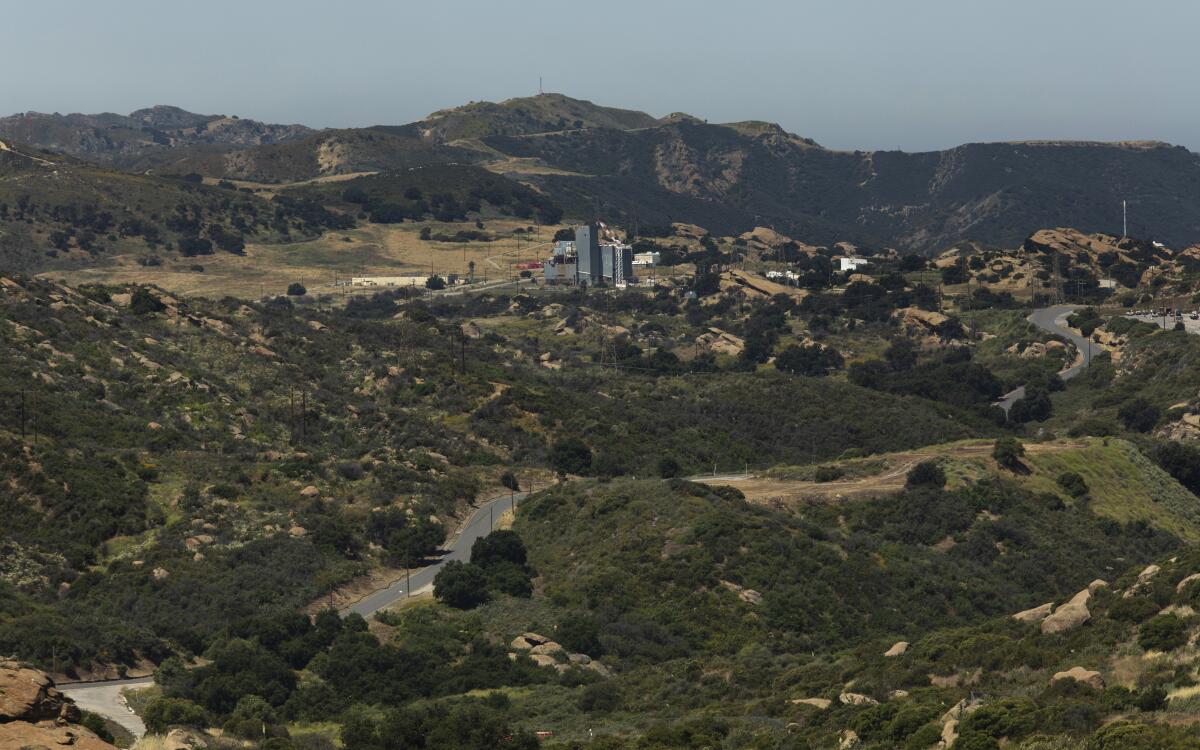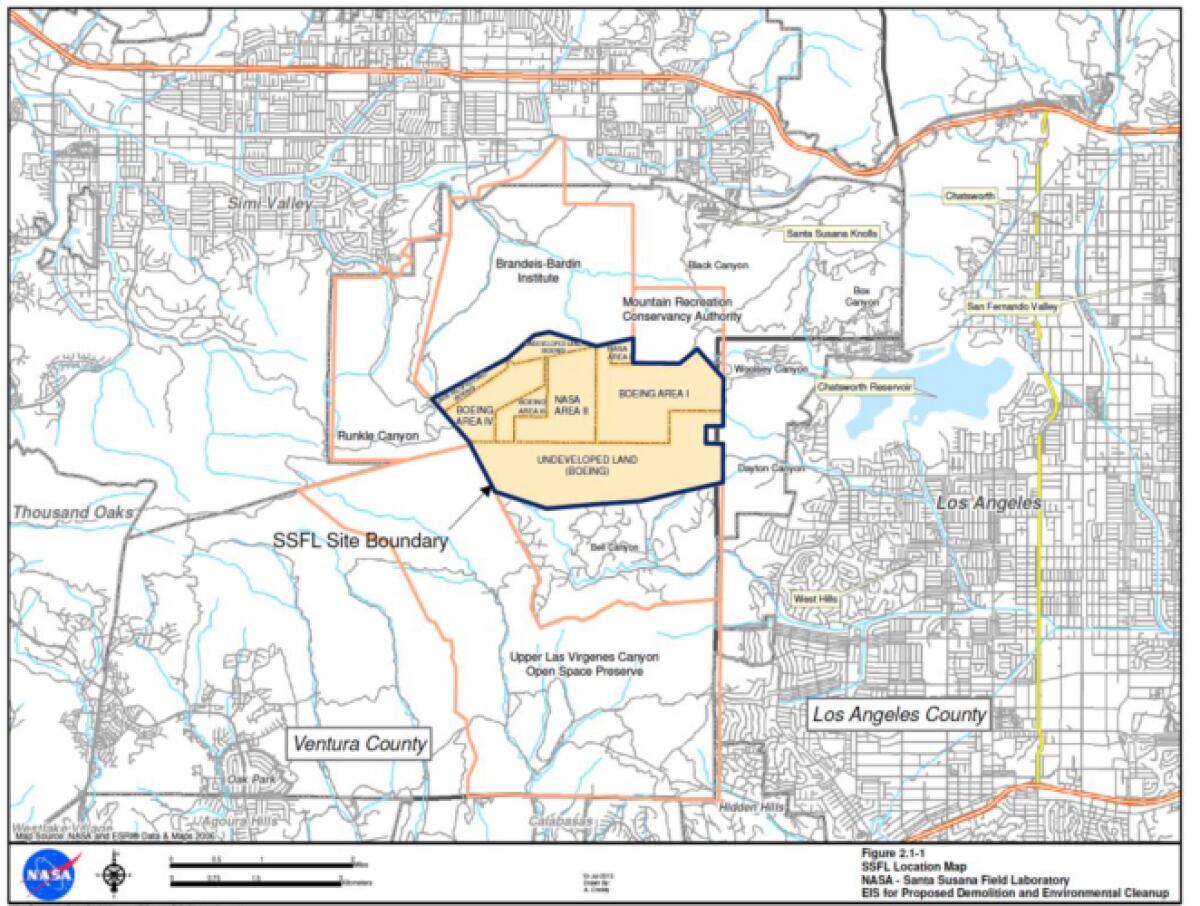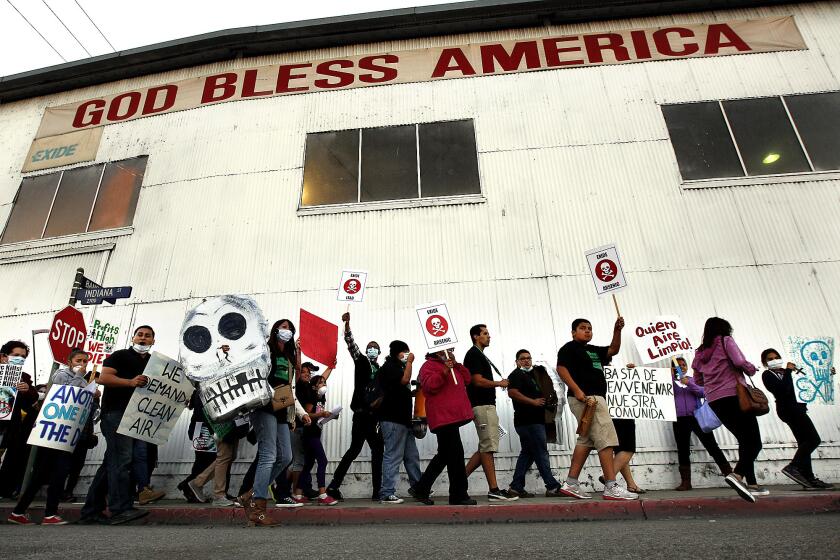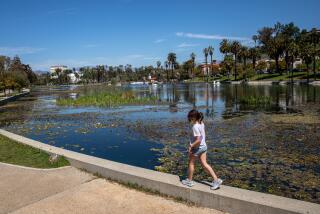Column: Did California give Boeing a pass on a major pollution cleanup?

Back in 2007, the state of California reached an agreement with Boeing Co. requiring the company to clean up the polluted site of the Santa Susana Field Laboratory, outside Simi Valley, to an exacting environmental standard.
The site, on 2,850 acres 30 miles from downtown Los Angeles, had been used for six decades as a government-sponsored rocket and nuclear testing complex. When the activities ceased in 2006, what was left behind was soil and water contaminated by radioactive detritus, PCBs, heavy metals, tricholoroethylene “and a witches’ brew of other poisons,” as the Natural Resources Defense Council once put it.
The site is “one of the most toxic sites in the United States by any kind of definition,” Jared Blumenfeld, head of the California Environmental Protection Agency, told me in 2020. “It demands a full cleanup.”
The state cut a backroom deal with a polluter.
— Daniel O. Hirsch, Santa Susana cleanup advocate
The 2007 agreement mandated in effect that a cleanup to “resident with garden” standards — that is, safe for people to live onsite and consume homegrown produce from a backyard garden — be completed by 2017.
Another agreement signed in 2010 by NASA and the U.S. Department of Energy committed those agencies to clean up the radiological contamination on the portion of the site where nuclear test reactors were located.
Get the latest from Michael Hiltzik
Commentary on economics and more from a Pulitzer Prize winner.
You may occasionally receive promotional content from the Los Angeles Times.
Boeing was held responsible for the chemical cleanup because it inherited the site through its acquisition of Rockwell International’s aerospace and defense businesses in 1996.
Most of the work has still not begun.
Now there’s a new chapter in the seemingly endless saga of Santa Susana. Blumenfeld’s agency opened secret negotiations with Boeing starting last year. The agency revealed the negotiations in May, when it unveiled the new agreement the talks had produced.
State officials boasted that the agreement “establishes strict cleanup protocols and timelines for The Boeing Company”; Gov. Gavin Newsom was quoted in the state’s news release to the effect that the deal “holds Boeing to account for its cleanup.”
Some close watchers of the saga beg to differ.
“The state cut a backroom deal with a polluter,” says Daniel O. Hirsch, retired director of the Program on Environmental and Nuclear Policy at UC Santa Cruz, who has been following the Santa Susana issue for some 40 years as president of the Committee to Bridge the Gap, an anti-nuclear group.
The government says Santa Susana should be a designated landmark, but it should be famous as a nuclear dump.
Hirsch contends that, contrary to the state’s assertion that the new agreement will “strengthen the cleanup of contaminated soil” at Santa Susana, it actually reduces the cleanup standards for more than 150 chemical pollutants on the site.
He’s not alone in expressing doubts. On Aug. 2, the Ventura County Board of Supervisors voted unanimously to join with the cities of Los Angeles and Simi Valley and the county of Los Angeles in contemplating a lawsuit to force a cleanup at Santa Susana to “background levels” — that is, environmental levels that would exist if the polluting activities on the site had never taken place.
The Los Angeles County Board of Supervisors is also prepped for legal action. On May 5, before the new Boeing agreement was unveiled, the board directed county lawyers “to explore potential legal action to ensure that the 2007 and 2010 agreements are carried out with “a full ‘cleanup to background.’”
The new agreement is not quite final. It’s subject to a confirmation vote, currently scheduled for Thursday, by the Los Angeles Regional Water Quality Control Board. If three of the five members eligible to vote reject the deal, it’s dead. “If they approve it, Boeing is home free,” Hirsch told me, “and the community is dead.”

That has prompted calls for the board at least to defer its vote.
Los Angeles County Supervisor Sheila Kuehl, who as a state senator introduced a bill in 2007 imposing strict standards on the cleanup, has called on the board to delay its vote for six weeks.
“After decades of advocacy and negotiations between government agencies and Boeing, it would be tragic if this decision were rushed, and the agreement ultimately be determined to fall short of the standards we’ve fought for,” she says. (Kuehl’s 2007 measure passed but was overturned in federal court in a case brought by Boeing.)
Blumenfeld says critics are misreading the new agreement as one that would weaken the cleanup.
The 2007 version was so ambiguous in its terms that it “left way too much wiggle room for Boeing,” he told me. “If the 2007 agreement was clear, unambiguous, and legally defensible, there wouldn’t have been an intervening 15 years between them signing it and my saying, ‘Let’s deal with this.’”
Of course, one reason for the 15-year stalemate is Boeing’s apparent determination to use every purported ambiguity to its own advantage. More on this later. Boeing says through a spokesman that it “supports the comprehensive framework with the State of California as it provides regulatory certainty and a clear, accelerated path forward for Boeing’s cleanup at the former Santa Susana Field Laboratory.”
Perhaps as befits a site so thoroughly contaminated, the history of Santa Susana is ugly in the extreme.
Problems there began in 1959, when a nuclear reactor partially melted down, contaminating portions of the hilltop facility and spewing radioactive gases into the atmosphere. That incident wasn’t publicly disclosed until 1979. Reactor accidents also occurred in 1964 and 1969.
Any way you cut it, the situation at the Santa Susana Field Laboratory site outside Simi Valley is a mess.
The area of radiological contamination is a parcel on the western edge of the site known as Area IV, where the meltdown occurred. Boeing owns that parcel along with the rest of the site, but the radiological cleanup there is in the hands of NASA and the Department of Energy.
The 2007 consent decree with the state didn’t explicitly mention a specific environmental standard, though Hirsch says the mandate was in effect for a cleanup to background levels.
Three years later, NASA and the Department of Energy agreed to restore the portion of property contaminated with nucleotides to background standards; Boeing wasn’t part of that agreement.
A 2007 state law mandated tough standards for the work. But Boeing successfully sued in federal court in 2009 to invalidate the law, arguing that it imposed tougher standards than other polluters faced in California.
In 2020, NASA audaciously applied to have the entire 2,850-acre site added to the National Register of Historic Places, which might have delayed its cleanup responsibilities.
A 12-acre portion of the site, encompassing the Burro Flats painted cave and a parcel traditionally used by Native Americans to observe the winter and summer solstices, has had a landmark listing since 1974. But NASA argued that its archeological research justified expanding the landmark designation to encompass the entire laboratory site.
NASA’s application was rejected by the National Park Service, which noted that the application hadn’t mentioned the environmental contamination of the site, an omission that “seems inappropriate.” NASA was invited to try again with a more complete application, but one hasn’t been submitted.
While all this has been going on, the area surrounding the lab has undergone suburban development. About 700,000 people now live within 10 miles of the site, in communities including Chatsworth, West Hills, Woodland Hills, Calabasas, Westlake Village and Simi Valley.
How government inaction and pro-business bankruptcy law enabled Exide to evade the cost of its environmental disaster
Boeing has consistently maintained that no reliable evidence of health effects among residents off the site have surfaced. But that claim was exploded in 2007 by epidemiologist Hal Morgenstern of the University of Michigan, who conducted a study that Boeing said found no increased incidence of cancer in the communities surrounding the lab.
In a letter to then-Sen. Joe Simitian (D-Palo Alto), who was conducting hearings on the 2007 bill, Morgenstern stated that “Boeing’s claim made about the conclusion of our study is false.”
In fact, Morgenstern stated, “For the period 1988 through 1995, we found that the incidence rate was more than 60% greater among residents living within 2 miles of SSFL than among residents living more than 5 miles from SSFL for the following types of cancer: thyroid, upper aerodigestive tract (oral and nasal cavities, pharynx, larynx, and esophagus), bladder, and blood and lymph tissue (leukemias, lymphomas, and multiple myelomas ).”
For 1996-2002, Morgenstern continued, “we found that the incidence rate of thyroid cancer was more than 60% greater among residents living within 2 miles of SSFL than for residents living more than 5 miles from SSFL.”
The results were “provocative,” he added, because other studies had linked thyroid cancer to environmental contaminants at Santa Susana and “found in the surrounding communities.” He accused Boeing in essence of cherry-picking his paper to emphasize its methodological limitations.
There’s no question that the twists and turns of the Santa Susana affair — cover-ups and lawsuits and bureaucratic tactics all leading away from rather than toward a cleanup — have left local residents and advocates deeply suspicious that any new development is beneficial.
Blumenfeld has been accused to reneging on a commitment he made at a 2020 public meeting not to negotiate with Boeing or the government agencies.
“Those are legally binding agreements,” he said then of the 2007 and 2010 orders. “We will hold them to those agreements. And as I said, but I will say it again: our job is to regulate, not to negotiate.”
Blumenthal says he meant that he would not negotiate to weaken the agreements’ terms, but that since the new agreement is more stringent in his view, it’s consistent with his commitment.
He also says that an approval vote by the Los Angeles water board won’t be the last word on the agreement — it would trigger action by the state’s Department of Toxic Substances Control to set down specific requirements, reached after public hearings, to be imposed on Boeing.
“It’s been a nightmarish site, and we hope to create light at the end of the tunnel,” he says. “I understand that some people still see darkness.” But he says he believes the state will be able to get the site “cleaned up to the standards we promised the community. And if we don’t we’ll be taking legal action against Boeing.”
If that sounds as if years of inconclusive activity may still lie ahead, that shouldn’t be a surprise. Think of how long it has taken to get nowhere.
More to Read
Get the latest from Michael Hiltzik
Commentary on economics and more from a Pulitzer Prize winner.
You may occasionally receive promotional content from the Los Angeles Times.












